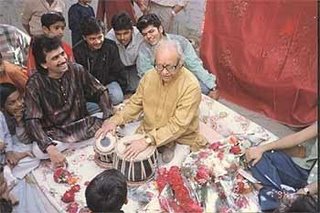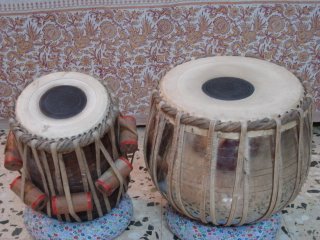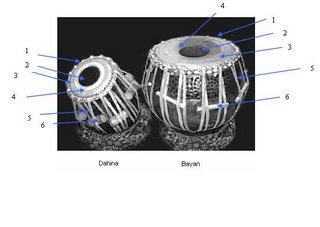In the picture above, Hariji can be seen in a casual attire and a very relaxed mood.
The dinner in progress...

In the picture above, Hariji can be seen in a casual attire and a very relaxed mood.
The dinner in progress...




Theka (Cyclic)
Theka, literally meaning ‘support’, is synonymous to the basic form of taal. It is extensively played in accompaniments with vocalists, instrumentalists or dancers to give the main artist a sense of cyclic rhythm, timing and beats within which he can perform. Variations/improvisations of a Theka are called ‘Prakars’. Theka is the most pure form of measure of time in Tabla. A beautifully played Theka is a treat to listen. During an accompaniment, even small but rightly timed improvisations in Theka add immense aesthetics to the music.
Kaida (Cyclic):
Structure:
Theka > Kaida > Variations > Tihai > Theka
Kaida is one of the most challenging aspect of Tabla playing. Kaida essentially means a ‘Rule’. The main theme of a Kaida comprises of a set of bols. The Tabla player is expected to use only the bols set out in the main theme and create improvised variations (‘Paltas’ or ’Vistars’) out of them. A continuity is generated in kaida where each phrase building the Palta is a variant of a preceding phrase.The virtuosity of a Tabla player is demonstrated by the number and type of Paltas played. The formation of Paltas is both an art and a science. Theoretically, innumerable Paltas could be created using different permutations and combinations of the bols in the main theme of the Kaida. However, the selection of logical variations is an art. Creating paltas is thus a creative challenge & depends largely on the tabla player’s virtuosity.
The kaida and the variations follow a ‘bharali-khali’ (‘Full-Empty’) pattern. The first part of the kaida/variation is call the ‘bharali’ and the second part, the ‘khali’. Bharali normally begins with baiya-predominant bols such as ‘Dha’, ‘Dhi’ or ‘Ge’. Khali normally begins with daya-predominant bol such as ‘Ta’ or ‘Ti’. However, some kaidas have khali beginning with flat bols such as ‘Ki’ or ‘Ke’ played on baiya.
Tihai (Cadential):
A Tihai (=’Three Times’) is a composition comprising of a phrase (pala) that is played three times. It may be set to one or more cycles of a Taal. A tihai normally ends on the first beat ( or Sam) of the rhythmic cycle. However, some tihai’s end before or after the Sam and are termed anagat tihai and atit tihai respectively.
The phrases of a tihai can be linked in one of two ways. One way is to use a time interval (pause) between the three palas (phrases). This is called a dumdar tihai. The second approach has no pause between phrases. This is referred to as bedum.
Tihais are one of the most frequently played rhythmic patterns in tabla and are an integral part of most forms of rhythmic compositions (i.e Kaida, Tukda, Rela etc). They have an equally important and irreplaceable role in all forms of Indian Classical music (i.e vocal, instrumental and dance).
Tukada (Cadential):
A Tukada (= ‘a piece’) is a short composition, generally comprising of heavy bols such as DhiTa’, Dhet, DhaGe, TeTa’ etc. As it is played with weighty strokes, Tukada is conspicuous by its absence in extremely light and folk styles of tabla playing. However, Tukadas are extensively played in solos and accompaniments with instruments and dance. Tukada could be plain or tihaidar/chakradar (ending with a tihai or having three palas).


